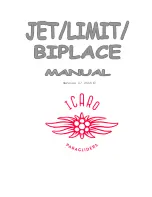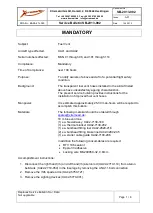
11
rate decreases and thermaling becomes easier. Adapt your piloting according to
the positions of trimmers and accelerator. Turns can be much tighter and more
effective with differential brake operation. A few cm of outer brake (with a deeper
application of inside brake) will reduce the sink rate during the turn. Turns can be
greatly enhanced by the additional use of the engine, throttle etc. When, with
experience you have mastered these techniques, you will be able to execute fully
coordinated and effective turns, comparable with those of other aircraft.
ACTIVE FLYING
The APAX has a high internal pressure, high resistance to tucking and a very high
level of
passive safety. Developing an active flying style will help you avoid collapses in
all but the most turbulent conditions. The key to active piloting is keeping the
glider above your head. If the glider pitches in front of you, apply brake to slow it
down. If the glider drops behind you, ease off the brakes to allow it to speed up.
The objective is to reduce the pendulum effect by adjusting the speed of your
glider so that glider and pilot are travelling at the same speed. If you feel a loss
of pressure in one or both sides of the wing, quickly apply the appropriate
brake(s) to re-gain pressure. Release the brake promptly as soon as normal
pressure is resumed. If you miss the above timing and get a collapse, be sure to
first raise your hands and release the brakes before considering any other
corrective actions.
-
Landing without an engine:
At an altitude of 50 meters, turn off the engine and start to descend like a
conventional paraglider. This reduces the chances of damaging the propeller while
landing. There is only one possible attempt - so the landing must be done correctly!
With or without the engine, the APAX reacts better in turbulence with the trimmers
open. Therefore, if the conditions are strong, it is better to make an approach with
greater speed, and use plenty of space to bleed off the speed before touching the
ground (like in hang gliding). The APAX has good energy retention, A long final
approach should be used to store energy for the flare. If you are attempting
precision landings or landing in nil wind, it is recommended to use the trimmers to
half or completely closed (maximum lift). Your performance in sink rate will be
better. This choice is even more crucial at a high wing loading.
-
Landing with an engine:
Make a flat approach with the engine idling, then stabilize and lose speed before
the final approach. Immediately after touchdown, switch off the engine. The main
advantage of this procedure is the possibility to abort the landing and repeat the
approach in case of bad judgment. However, if you forget to turn off the engine
before the wing deflates there is a considerable risk of damaging your propeller,
catching lines, or even injuring yourself by falling with your gear on.












































